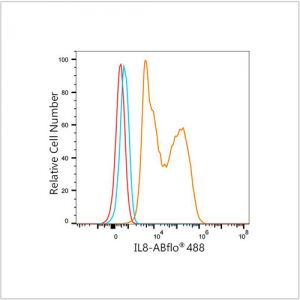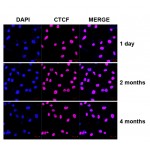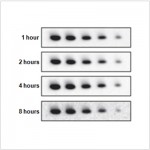ABflo® 488 Rabbit anti-Human IL8 mAb (100 T)
| Reactivity: | Human |
| Applications: | FC (intra) |
| Host Species: | Rabbit |
| Isotype: | IgG |
| Clonality: | Monoclonal Antibody |
| Conjugation: | ABflo® 488. Ex:491nm. Em:516nm. |
| Gene Name: | C-X-C motif chemokine ligand 8 |
| Gene Symbol: | CXCL8 |
| Synonyms: | IL8; NAF; GCP1; LECT; LUCT; NAP1; GCP-1; LYNAP; MDNCF; MONAP; NAP-1; SCYB8 |
| Gene ID: | 3576 |
| UniProt ID: | P10145 |
| Clone ID: | 6E5I7 |
| Immunogen: | Recombinant fusion protein containing a sequence corresponding to amino acids 28-99 of human IL8(NP_000575.1). |
| Dilution: | FC (intra),5 μl per 10^6 cells in 100 μl volume |
| Purification Method: | Affinity purification |
| Concentration: | 0.01 mg/mL |
| Buffer: | PBS with 0.03% proclin300,0.2% BSA, pH7.3. |
| Storage: | Store at -20°C. Avoid freeze / thaw cycles. |
| Documents: | Manual-CXCL8 Antibody |
Background
The protein encoded by this gene is a member of the CXC chemokine family and is a major mediator of the inflammatory response. The encoded protein is commonly referred to as interleukin-8 (IL-8). IL-8 is secreted by mononuclear macrophages, neutrophils, eosinophils, T lymphocytes, epithelial cells, and fibroblasts. It functions as a chemotactic factor by guiding the neutrophils to the site of infection. Bacterial and viral products rapidly induce IL-8 expression. IL-8 also participates with other cytokines in the proinflammatory signaling cascade and plays a role in systemic inflammatory response syndrome (SIRS). This gene is believed to play a role in the pathogenesis of the lower respiratory tract infection bronchiolitis, a common respiratory tract disease caused by the respiratory syncytial virus (RSV). The overproduction of this proinflammatory protein is thought to cause the lung inflammation associated with csytic fibrosis. This proinflammatory protein is also suspected of playing a role in coronary artery disease and endothelial dysfunction. This protein is also secreted by tumor cells and promotes tumor migration, invasion, angiogenesis and metastasis. This chemokine is also a potent angiogenic factor. The binding of IL-8 to one of its receptors (IL-8RB/CXCR2) increases the permeability of blood vessels and increasing levels of IL-8 are positively correlated with increased severity of multiple disease outcomes (eg, sepsis). This gene and other members of the CXC chemokine gene family form a gene cluster in a region of chromosome 4q.
Images
 | Flow cytometry: 1×10^6 293T cells (negative control,left) and 293T (Transfection,right) cells were intracellularly-stained with ABflo® 488 Rabbit anti-Human IL8 mAb (A24959,5 μl/Test,orange line) or ABflo® 488 Rabbit IgG isotype control (A22069,5 μl/Test,blue line). Non-fluorescently stained cells were used as blank control (red line). |
 | Flow cytometry: 1×10^6 293T (Transfection) cells were intracellularly-stained with ABflo® 488 Rabbit IgG isotype control (A22069,5 μl/Test,left) or ABflo® 488 Rabbit anti-Human IL8 mAb (A24959,5 μl/Test,right). |
You may also be interested in:



